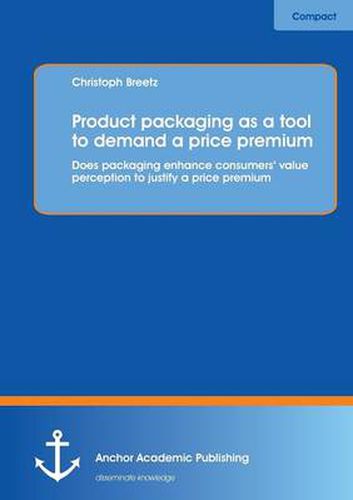Readings Newsletter
Become a Readings Member to make your shopping experience even easier.
Sign in or sign up for free!
You’re not far away from qualifying for FREE standard shipping within Australia
You’ve qualified for FREE standard shipping within Australia
The cart is loading…






This title is printed to order. This book may have been self-published. If so, we cannot guarantee the quality of the content. In the main most books will have gone through the editing process however some may not. We therefore suggest that you be aware of this before ordering this book. If in doubt check either the author or publisher’s details as we are unable to accept any returns unless they are faulty. Please contact us if you have any questions.
This study addresses the question of the impact of packaging to demand a price premium leveraging the example of retailer brand premium products in the food segment in Germany. Product tiering is a pricing structure that is commonly used by producers, in which consumers are segmented by willingness to pay for specific (added) product benefits. This is a way of maximizing utility for both consumers and producers, and is commonly already leveraged by producers of branded products, but lately also by retailer brands, especially to enable growth outside the value tier. This research uses a survey across grocery purchase decision makers in Germany to identify the relationship of packaging and willingness to pay across a sample of retailer brand Tier 1, Tier 2 and Tier 3 products as well as a branded product in four different grocery categories. The intent is to answer whether i) packaging currently justifies the premium price of retailer brand tier 1 products compared to other product tiers, ii) packaging justifies the tier 1 retailer brand price premium, and iii) demographics influence the willingness to pay a premium price.
$9.00 standard shipping within Australia
FREE standard shipping within Australia for orders over $100.00
Express & International shipping calculated at checkout
This title is printed to order. This book may have been self-published. If so, we cannot guarantee the quality of the content. In the main most books will have gone through the editing process however some may not. We therefore suggest that you be aware of this before ordering this book. If in doubt check either the author or publisher’s details as we are unable to accept any returns unless they are faulty. Please contact us if you have any questions.
This study addresses the question of the impact of packaging to demand a price premium leveraging the example of retailer brand premium products in the food segment in Germany. Product tiering is a pricing structure that is commonly used by producers, in which consumers are segmented by willingness to pay for specific (added) product benefits. This is a way of maximizing utility for both consumers and producers, and is commonly already leveraged by producers of branded products, but lately also by retailer brands, especially to enable growth outside the value tier. This research uses a survey across grocery purchase decision makers in Germany to identify the relationship of packaging and willingness to pay across a sample of retailer brand Tier 1, Tier 2 and Tier 3 products as well as a branded product in four different grocery categories. The intent is to answer whether i) packaging currently justifies the premium price of retailer brand tier 1 products compared to other product tiers, ii) packaging justifies the tier 1 retailer brand price premium, and iii) demographics influence the willingness to pay a premium price.